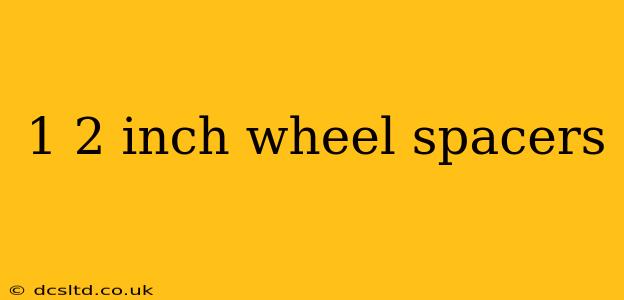Are you considering installing 1.2-inch wheel spacers on your vehicle? This comprehensive guide will delve into the benefits, drawbacks, and crucial considerations before making this modification. We'll answer frequently asked questions and help you determine if 1.2-inch wheel spacers are the right choice for your car or truck.
What are Wheel Spacers?
Wheel spacers are precisely engineered metal rings that fit between your vehicle's wheel hub and the wheel itself. They effectively push the wheels further outward, altering the vehicle's track width. A 1.2-inch spacer increases the track width by 2.4 inches (1.2 inches per side). This seemingly small change can have a significant impact on your vehicle's appearance and handling.
Benefits of Using 1.2-Inch Wheel Spacers
-
Improved Aesthetics: Many car enthusiasts use spacers to improve the visual stance of their vehicles. By pushing the wheels outwards, they create a more aggressive and filled-out look, often filling the wheel wells more completely. This is especially noticeable on vehicles with larger wheels and tires.
-
Enhanced Handling (Potentially): A wider track width generally improves vehicle stability and reduces body roll, especially during cornering. This enhanced stability can lead to a more confident driving experience. However, this benefit is contingent on proper installation and the overall suspension setup.
-
Brake Caliper Clearance: In some cases, 1.2-inch wheel spacers can provide the necessary clearance to accommodate larger brake calipers or aftermarket wheels that might otherwise interfere with the factory brakes.
Drawbacks of Using 1.2-Inch Wheel Spacers
-
Increased Stress on Wheel Bearings and Studs: Spacers add leverage to the wheel studs and increase stress on the wheel bearings. Improperly installed spacers, or using low-quality spacers, can lead to premature wear and even catastrophic failure of these components.
-
Potential for Rubbing: Depending on your vehicle, tire size, and suspension setup, the wider track width might cause tire rubbing against the fenders, suspension components, or other parts of the chassis.
-
ABS and Stability Control Issues: Some vehicles may experience issues with their Anti-lock Braking System (ABS) and Electronic Stability Control (ESC) after installing wheel spacers. The change in wheel position can disrupt the sensor readings, leading to malfunctioning systems.
-
Wheel Alignment: Installing wheel spacers necessitates a wheel alignment to ensure the vehicle's handling and tire wear remain optimal. Ignoring this step can result in uneven tire wear and compromised handling.
Are 1.2-Inch Wheel Spacers Safe?
The safety of 1.2-inch wheel spacers depends entirely on several factors:
-
Quality of the Spacer: Invest in high-quality, hub-centric spacers made from durable materials like forged aluminum or billet steel. Cheap spacers are often prone to cracking or bending under stress.
-
Proper Installation: Wheel spacers must be installed correctly, using the appropriate lug nuts and torque specifications. Incorrect installation can lead to wheel detachment.
-
Vehicle Compatibility: Ensure the spacers are compatible with your specific vehicle make, model, and year. Incorrectly sized spacers might not fit properly and compromise safety.
-
Overall Vehicle Setup: Consider the vehicle's suspension, braking system, and tire size before installation. A thorough assessment minimizes safety risks.
What Size Lug Bolts Do I Need With Wheel Spacers?
You'll need longer lug bolts or studs to accommodate the added thickness of the wheel spacers. The necessary length will vary depending on the spacer thickness, wheel thickness, and the original lug bolt length. It's crucial to determine the appropriate lug bolt length to avoid issues. Consult a qualified mechanic or wheel and tire specialist for guidance.
Can I Use 1.2-Inch Wheel Spacers on Any Car?
No, 1.2-inch wheel spacers are not universally compatible. Their suitability depends heavily on the vehicle's design, suspension geometry, and tire size. Some vehicles have limited clearance and may experience rubbing or interference with the installation of spacers.
What are the Best 1.2-Inch Wheel Spacers?
Determining the "best" wheel spacers involves considering several factors, including material, construction, and reputation of the manufacturer. Research reputable brands known for producing high-quality wheel spacers. Look for spacers that are hub-centric to ensure proper wheel centering and prevent vibrations.
Conclusion
1.2-inch wheel spacers can offer aesthetic and handling improvements, but they come with potential drawbacks and safety risks. Thorough research, careful selection of high-quality spacers, and professional installation are paramount to ensure safety and prevent premature wear. Always consult with a qualified mechanic before making this modification to your vehicle.
